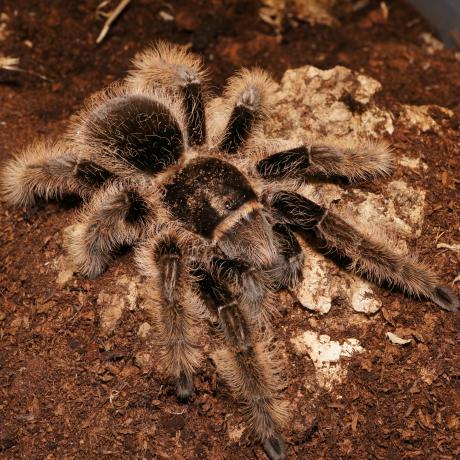

Still one of the best beginner species of tarantula. These spiderlings have come from wild caught parents in Nicaragua so no risk of hybrids.
| Lifestyle | Terrestrial |
|---|---|
| Adult Size | 15-17cm |
| Growth Rate | Average |
| Environment | Tropical scrubland |
| Suitability | Beginner |
| Temperament | Docile |
What does the Curly Hairs look like?
There are two types of commonly known Curly Hair tarantulas known as hobby form and True form. Both hobby form and true forms are heavy bodied with brown to black hairs. True Curly hairs (non hybrids) have longer golden brown hairs coving its legs, these hairs give the spiders a beautiful sheen and almost make them look fuzzy. Hobby type Curly hairs do not have the same amount of hairs due to hybridisation with other closely related Brachypelma species. Though there are dimorphic differences in appearance, the care for both the true and hobby forms are the same.
Curly Hairs have been found thriving in a few different locations along the Atlantic side of Costa Rica, Honduras and Nicaragua. They are a semi-burrowing species found in tropical scrubland usually living close by to a water source.
Curly Hairs are one of the most ‘common’ species to own due to how easy they are to care for and also because of their docile nature. Glass or plastic ventilated enclosures both make great housing options. Deep substrate such as moss peat or coco fibre should be used to allow the tarantula to burrow if it wants too. Cork bark can also be buried into the substrate to create a natural hide for those that choose not to burrow. A water dish should always be available in the enclosure for the tarantula to drink from. Plain water is absolutely fine for tarantulas please don’t use Bug gel or balls as tarantulas cannot drink from them. A sponge shouldn’t be used either as this can attract bacteria growth in the set up.
Humidity for this species should remain around 70-80%. This can be achieved by overfilling the tarantula’s water bowl and allowing it dry out in the enclosure. For spiderlings spraying one side of the enclosure will allow them to drink the water droplets.
Room temperature is generally ok for most tarantula species but as Curly Hairs come from a warm and humid climate we do recommend the use of a heat mat if your house is not normally warm. When using heat mats always use a thermostat alongside to help with temperature control and prevent overheating. Curly hairs require temperatures of 24-28C (75-82F).
When it comes to feeding we recommend micro or small crickets for spiderlings, juveniles and adults will feed on a variety of bigger live food including crickets, roaches, mealworms and locusts.